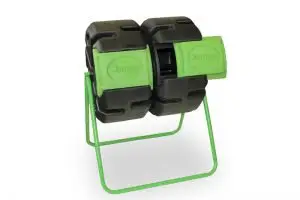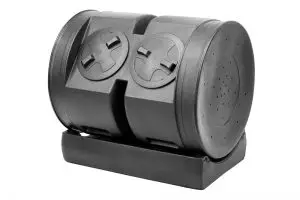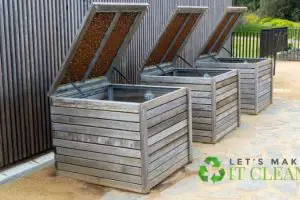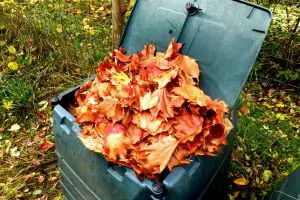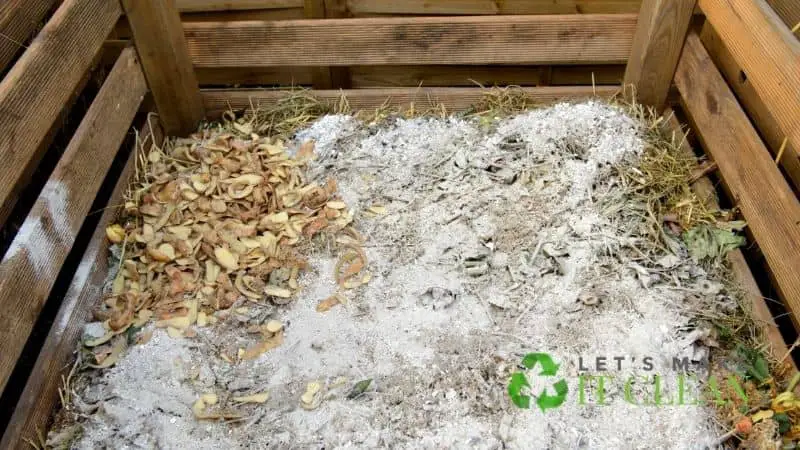Proper aeration of your compost helps the aerobic bacteria to breakdown the waste into useful nutrients. Ensure you have a method for compost aeration.

Have you noticed an unpleasant smell coming from your compost bin?
Quick Navigation
With the right aeration, a compost bin is not supposed to release an unpleasant odor. As such, any stink should be a red flag that everything is not well with your compost. Apart from the bad smell, a poorly aerated compost pile becomes slummy due to the lack of oxygen.
Some people who refer a compost bin to a compost pile even have it in their apartments. Can you imagine the slummy smell of unhealthy compost in your apartment?
How can you ensure that your composting process results in a healthy compost pile?
Does a Compost Bin Need Ventilation?
Can you have a healthy compost pile without proper ventilation? Do you need airflow during the composting process?
To have a healthy compost pile that will result in the best compost for your garden, you should make sure you have all the ingredients. Such ingredients include composting material rich in carbon and others that are carbon-rich. The goal is to strike a balance between the two.
However, even with the best materials, you will still end up with an unhealthy compost pile if there is no proper aeration. Oxygen is a vital ingredient in composting. Without it, the aerobic bacteria that work in your compost pile cease to work leading to a bad smell.
With the proper carbon and oxygen balance, the bacteria work well, resulting in a finished compost with an earthly smell.
When you put the composting materials in the compost heap, there are air pockets, almost microscopic, inside the grass clippings, dry leaves, shredded newspapers, and other kitchen waste.
As the decomposition process continues, the garden waste and other materials become compacted, and the air pockets disappear, affecting the aeration system.
When the supply of oxygen dwindles, the functions of the aerobic composting microorganisms also goes down and eventually stops. After the compaction, the decomposition process stops, and the anaerobic bacteria that don’t require air to function take over.
The bacteria are responsible for the unpleasant smell from your compost heap. As you try to ensure the compost is well aerated, you should also check the moisture content. If the compost is soaking wet, the aerobic bacteria cease to function.
As you try to aerate the compost, you should try as much as possible to get to the center of the pile where the temperatures are high. Getting oxygen to the center of the pile speeds up the decomposition process.
It also keeps the temperatures high, which is vital for a hot composting process. Hot composting helps to get rid of plant pests, weed seeds, and diseases.
How Much Air Does a Compost Bin Need?
Food waste and other scraps in the compost pile decompose through an aerobic process that requires air. The air we breathe is about 21 percent oxygen.
The organisms in the compost bin can survive with as little as 5% oxygen. If the oxygen levels fall under 10%, the compost pile can become anaerobic.
Oxygen is most limited at the center of the compost piles. Air can flow passively 3 feet into the compost piles and should not be more than 6 feet across.
If you want to go larger than the 6 feet or increase aeration, you can put an aeration tube in the center of the pile.
You can make the tube from a hardware cloth or a PVC pipe that is taller than the compost, and it should have holes drilled on its entire length.
However, this method is not the best if you are looking for hot composting as it releases temperatures from the center of the piles.
Turn the Compost Around
As mentioned earlier, the air drain in the compost pile happens as the compost becomes compact. As such, to allow airflow, you should turn the pile often.
Of all the methods, none is as efficient in letting in a lot of oxygen as turning the pile.
Turning the compost allows for redistribution of the compost materials and exposing more materials at the center of the pile where the temperatures are higher.
How often you turn the pile depends on the moisture in the pile, size, and carbon to nitrogen ratio.
Ordinarily, you should turn a compost pile after three to seven days and a compost tumbler every three to four days.
A compost tumbler offers an easier way of turning the compost materials than hand turning. It was discovered years ago, and it is easy to use. To jumpstart the composting process in a tumbler, you can use a spadeful garden soil, manure, or finished compost.
It would be best if you turned the tumbler at least 3 days a week. Turning the tumbler many times in a day is not recommended as it doesn’t give it enough time to attain maximum temperatures.
You should ensure you breakdown the fresh materials whether you are using a one bin system or a pile. When large pieces of fresh materials such as cabbages, carrots, etc., are left as they are, they soften and compact faster in your pile.
The benefit of chopping the materials into smaller pieces is that they compost faster and also allow aeration. Also, ensure there is a balance between the greens and the browns. This ensures there is a balance between nitrogen and carbon, thus preventing bad odor even without turning.
If you have grass clippings and other weeds in your bin, ensure you distribute them throughout the pile instead of leaving them as a heap.
Twigs and sticks will make it hard to turn the compost. If you want to use sticks, then ensure you break them down into small pieces.
You can use a fork or a spade to turn the pile. But instead of the fork, it would be best if you use some compost aerators such as a Wing Digger (see it on Amazon). A hand cultivator also comes in handy.
You can use the stab and twist method to ensure you eliminate all the anaerobic pots in the bin. You stab the heap and then pull the hand cultivator upwards as you turn it. Several stabs and twists make the heap looser, which allows air to pass through easily.
What Is the Best Location for a Compost Bin?

After buying the compost bin, the next question you have to struggle with is, “Where should you keep the bin?”
Although this may seem like a straightforward question, you should consider it as it significantly impacts the process.
Ordinarily, the bins are placed in one corner of the garden. However, you should ensure that it is easily accessible and away from any leaking liquids or smells that can be a nuisance.
Plus, the location should be on a level and well-drained ground and exposed to sunlight. Exposure to light offers the best conditions for composting as a cold location slows down the process.
A well-chosen location should be convenient for you and make it possible for the compost to work.
So, what factors should you consider as you look for an appropriate location for home composting?
Look at it this way.
Imagine it is raining outside, and the kitchen scraps in the kitchen are becoming too much. Would you be willing for even one bit to move the scraps outside?
What if you put it too close to the kitchen and have more greens than browns in the mixture. The imbalance may cause the pile to be smelly, which would be uncomfortable.
Here are a few tips to help you find the bin’s perfect location and avoid any mess.
Not Too Cold
Why are compost bins dark in color?
The reason most bins are black or dark is so that they can absorb and retain heat, which is vital in the decomposing process.
What happens if you choose a location that is too cold?
The process will take longer as cold weather slows down the process. The perfect location should be exposed to sunlight as it helps in warming the pile and make the process faster.
Warm but Not Hot
The location for your backyard compost bin should be warm but not too hot. If it is hot, it will fasten the process but will also dry the pile fast.
It would be best if you struck a balance such that your choice of location will expose the pile to enough temperatures and maintain moisture.
A location that receives shades at some times of the day would be ideal as you won’t have to water the pile several times.
Don’t Put the Bin Under a Tree
If you put the bin near a tree, the roots may find their way into the pile.
Although this seems like a perfect location for keeping the pile cool, the roots may find their way to the bottom of the pile, searching for water and nutrients.
Distance
Ensure the bin is not too far away from the kitchen or too close. If the location is too far, it can be tiring carrying the scraps to the bin. If it is too far, you can even start tending to it.
On the other hand, if it is too close, you can have unpleasant smells in the house if there are anaerobic spots.
Avoid Windy Areas
The same way a too hot location dries out the pile, a windy locating can dry it out.
It would be best if you went for a location with windbreakers.
Is There an Easier Way to Aerate My Compost Besides Turning It?
Yes, there is. Instead of hand turning the compost yourself, you can let it aerate itself. There are several methods that you can use to have the pile aerate itself.
For instance, you can have PVC tubes running from the center of the pile.
The tube should be taller and perforated on the sides to allow air to pass through to the center of the compost. The method is not ideal if you are looking for hot composting as it doesn’t allow maximum temperatures at the center of the heap.
Alternatively, you can have large items at the bottom of the heap to allow air to pass freely.
Note, the bulky items may not decompose completely as the rest of the ingredients, but they will enhance aeration resulting in a healthy compost.
Conclusion
Aeration is an integral part of composting. Apart from ensuring you have the right balance between the greens and browns in a heap, the next step towards a healthy compost is ensuring it is well aerated.
You can use several methods to aerate the pile, irrespective of your composting system. The methods include turning the heap, using a tube, or even letting the pile aerate itself from the bottom. If you go for the turning method, there are more than enough tools to come in handy.

